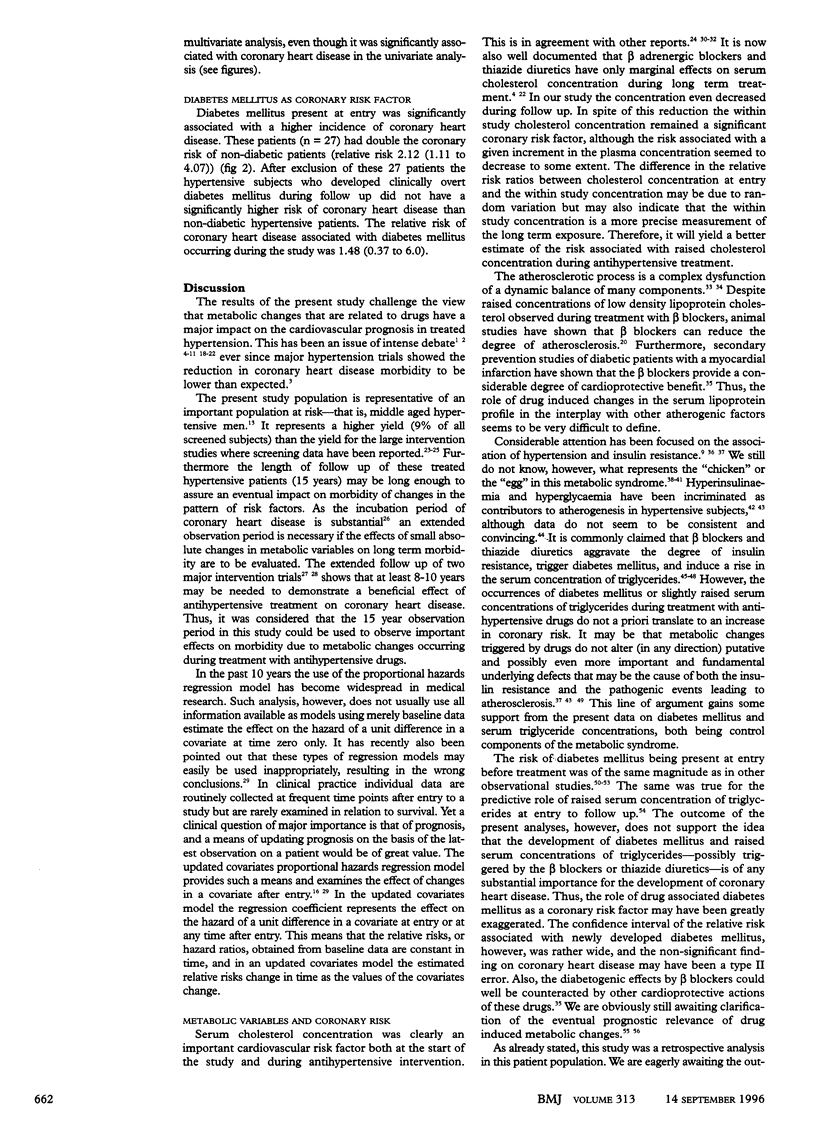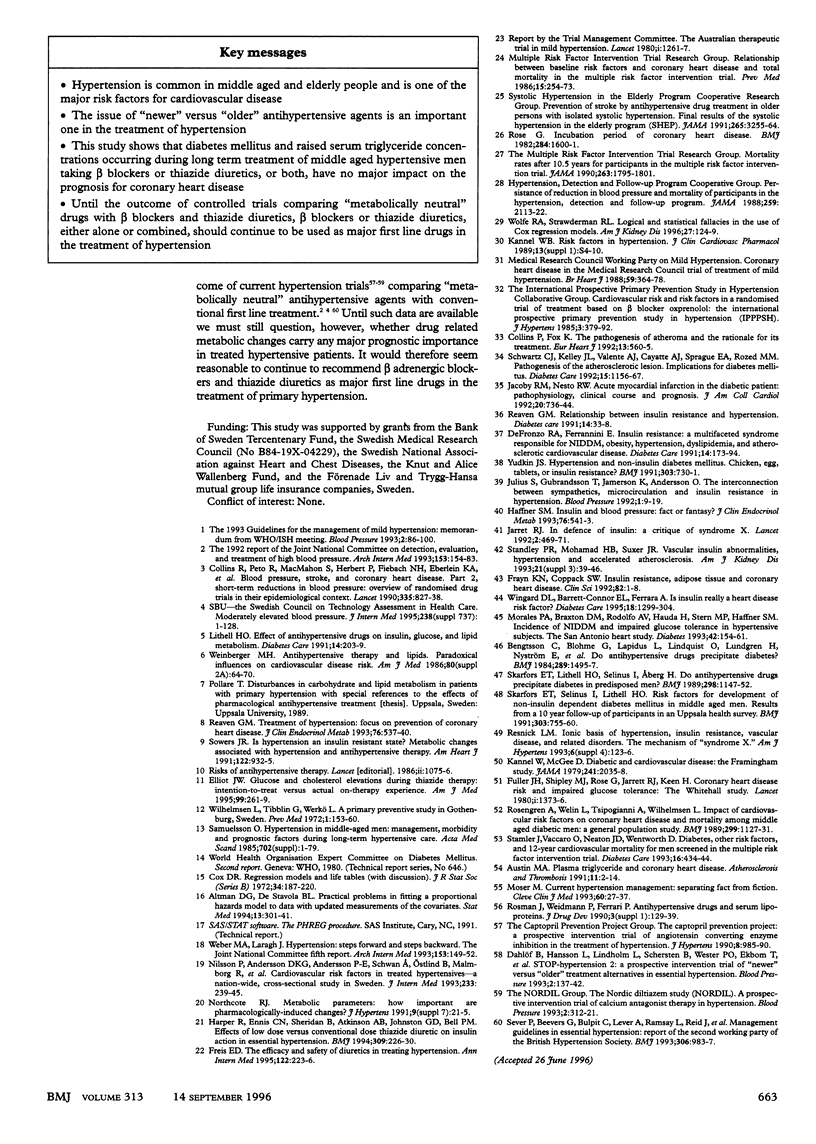Abstract
OBJECTIVE: To analyse whether metabolic changes during long term treatment with antihypertensive drugs are associated with an increased risk of coronary heart disease. DESIGN: Observational study. SETTING: Gothenburg, Sweden. SUBJECTS: 686 middle aged hypertensive men, recruited after screening of a random population sample, and followed for 15 years during treatment with predominantly beta adrenoceptor blockers or thiazide diuretics, or both. Coronary heart disease and diabetes mellitus were registered at yearly patient examinations. Entry characteristics, as well as within study serum concentrations of cholesterol and triglycerides and the development of diabetes mellitus, were related to the incidence of coronary heart disease in a time dependent Cox's regression analysis. MAIN OUTCOME VARIABLE: Coronary heart disease morbidity. RESULTS: Diabetes mellitus, raised serum cholesterol and triglyceride concentrations present at the beginning of the study were all significantly predictive of coronary heart disease in univariate analysis. The relative risk of diabetes mellitus and of a 1 mmol/l increase in the cholesterol and triglyceride concentrations was 2.12 (95% confidence interval 1.11 to 4.07), 1.21 (1.05 to 1.39), and 1.21 (1.03 to 1.43) respectively. However, when the within study metabolic variables were analysed, only the serum cholesterol concentration was significantly and independently associated with coronary heart disease (relative risk 1.07 (1.02 to 1.13)). Although the triglyceride concentrations increased slightly during the follow up, the within study serum triglyceride concentrations were not associated with the incidence of coronary heart disease (1.04 (0.96 to 1.10)). New diabetes mellitus-that is, onset during follow up-was not significantly associated with an increased risk for coronary heart disease (1.48 (0.37 to 6.00)). CONCLUSIONS: Metabolic disturbances such as diabetes mellitus and hyperlipidaemia presenting before the start of antihypertensive treatment have a prognostic impact in middle aged, treated hypertensive men. Moreover, while within study cholesterol concentration was an independent predictor of coronary heart disease, drug related diabetes mellitus and raised serum triglyceride concentrations that are associated with treatment do not seem to have any major impact on the coronary heart disease prognosis in this category of patients.
Full text
PDF



Selected References
These references are in PubMed. This may not be the complete list of references from this article.
- Altman D. G., De Stavola B. L. Practical problems in fitting a proportional hazards model to data with updated measurements of the covariates. Stat Med. 1994 Feb 28;13(4):301–341. doi: 10.1002/sim.4780130402. [DOI] [PubMed] [Google Scholar]
- Austin M. A. Plasma triglyceride and coronary heart disease. Arterioscler Thromb. 1991 Jan-Feb;11(1):2–14. doi: 10.1161/01.atv.11.1.2. [DOI] [PubMed] [Google Scholar]
- Bengtsson C., Blohmé G., Lapidus L., Lindquist O., Lundgren H., Nyström E., Petersen K., Sigurdsson J. A. Do antihypertensive drugs precipitate diabetes? Br Med J (Clin Res Ed) 1984 Dec 1;289(6457):1495–1497. doi: 10.1136/bmj.289.6457.1495. [DOI] [PMC free article] [PubMed] [Google Scholar]
- Collins P., Fox K. The pathogenesis of atheroma and the rationale for its treatment. Eur Heart J. 1992 Apr;13(4):560–565. doi: 10.1093/oxfordjournals.eurheartj.a060214. [DOI] [PubMed] [Google Scholar]
- Collins R., Peto R., MacMahon S., Hebert P., Fiebach N. H., Eberlein K. A., Godwin J., Qizilbash N., Taylor J. O., Hennekens C. H. Blood pressure, stroke, and coronary heart disease. Part 2, Short-term reductions in blood pressure: overview of randomised drug trials in their epidemiological context. Lancet. 1990 Apr 7;335(8693):827–838. doi: 10.1016/0140-6736(90)90944-z. [DOI] [PubMed] [Google Scholar]
- DeFronzo R. A., Ferrannini E. Insulin resistance. A multifaceted syndrome responsible for NIDDM, obesity, hypertension, dyslipidemia, and atherosclerotic cardiovascular disease. Diabetes Care. 1991 Mar;14(3):173–194. doi: 10.2337/diacare.14.3.173. [DOI] [PubMed] [Google Scholar]
- Elliott W. J. Glucose and cholesterol elevations during thiazide therapy: intention-to-treat versus actual on-therapy experience. Am J Med. 1995 Sep;99(3):261–269. doi: 10.1016/s0002-9343(99)80158-2. [DOI] [PubMed] [Google Scholar]
- Frayn K. N., Coppack S. W. Insulin resistance, adipose tissue and coronary heart disease. Clin Sci (Lond) 1992 Jan;82(1):1–8. doi: 10.1042/cs0820001. [DOI] [PubMed] [Google Scholar]
- Freis E. D. The efficacy and safety of diuretics in treating hypertension. Ann Intern Med. 1995 Feb 1;122(3):223–226. doi: 10.7326/0003-4819-122-3-199502010-00011. [DOI] [PubMed] [Google Scholar]
- Fuller J. H., Shipley M. J., Rose G., Jarrett R. J., Keen H. Coronary-heart-disease risk and impaired glucose tolerance. The Whitehall study. Lancet. 1980 Jun 28;1(8183):1373–1376. doi: 10.1016/s0140-6736(80)92651-3. [DOI] [PubMed] [Google Scholar]
- Haffner S. M. Insulin and blood pressure: fact or fantasy? J Clin Endocrinol Metab. 1993 Mar;76(3):541–543. doi: 10.1210/jcem.76.3.8445008. [DOI] [PubMed] [Google Scholar]
- Harper R., Ennis C. N., Sheridan B., Atkinson A. B., Johnston G. D., Bell P. M. Effects of low dose versus conventional dose thiazide diuretic on insulin action in essential hypertension. BMJ. 1994 Jul 23;309(6949):226–230. doi: 10.1136/bmj.309.6949.226. [DOI] [PMC free article] [PubMed] [Google Scholar]
- Jacoby R. M., Nesto R. W. Acute myocardial infarction in the diabetic patient: pathophysiology, clinical course and prognosis. J Am Coll Cardiol. 1992 Sep;20(3):736–744. doi: 10.1016/0735-1097(92)90033-j. [DOI] [PubMed] [Google Scholar]
- Julius S., Gudbrandsson T., Jamerson K., Andersson O. The interconnection between sympathetics, microcirculation, and insulin resistance in hypertension. Blood Press. 1992 May;1(1):9–19. doi: 10.3109/08037059209065119. [DOI] [PubMed] [Google Scholar]
- Kannel W. B., McGee D. L. Diabetes and cardiovascular disease. The Framingham study. JAMA. 1979 May 11;241(19):2035–2038. doi: 10.1001/jama.241.19.2035. [DOI] [PubMed] [Google Scholar]
- Kannel W. B. Risk factors in hypertension. J Cardiovasc Pharmacol. 1989;13 (Suppl 1):S4–10. doi: 10.1097/00005344-198900131-00003. [DOI] [PubMed] [Google Scholar]
- Lithell H. O. Effect of antihypertensive drugs on insulin, glucose, and lipid metabolism. Diabetes Care. 1991 Mar;14(3):203–209. doi: 10.2337/diacare.14.3.203. [DOI] [PubMed] [Google Scholar]
- Morales P. A., Mitchell B. D., Valdez R. A., Hazuda H. P., Stern M. P., Haffner S. M. Incidence of NIDDM and impaired glucose tolerance in hypertensive subjects. The San Antonio Heart Study. Diabetes. 1993 Jan;42(1):154–161. doi: 10.2337/diab.42.1.154. [DOI] [PubMed] [Google Scholar]
- Moser M. Current hypertension management: separating fact from fiction. Cleve Clin J Med. 1993 Jan-Feb;60(1):27–37. doi: 10.3949/ccjm.60.1.27. [DOI] [PubMed] [Google Scholar]
- Nilsson P., Andersson D. K., Andersson P. E., Schwan A., Ostlind B., Malmborg R., Lithell H., Andersson O. K. Cardiovascular risk factors in treated hypertensives--a nation-wide, cross-sectional study in Sweden. J Intern Med. 1993 Mar;233(3):239–245. doi: 10.1111/j.1365-2796.1993.tb00982.x. [DOI] [PubMed] [Google Scholar]
- Reaven G. M. Clinical review 43: Treatment of hypertension: focus on prevention of coronary heart disease. J Clin Endocrinol Metab. 1993 Mar;76(3):537–540. doi: 10.1210/jcem.76.3.8445007. [DOI] [PubMed] [Google Scholar]
- Rose G. Incubation period of coronary heart disease. Br Med J (Clin Res Ed) 1982 May 29;284(6329):1600–1601. doi: 10.1136/bmj.284.6329.1600. [DOI] [PMC free article] [PubMed] [Google Scholar]
- Rosengren A., Welin L., Tsipogianni A., Wilhelmsen L. Impact of cardiovascular risk factors on coronary heart disease and mortality among middle aged diabetic men: a general population study. BMJ. 1989 Nov 4;299(6708):1127–1131. doi: 10.1136/bmj.299.6708.1127. [DOI] [PMC free article] [PubMed] [Google Scholar]
- Samuelsson O. Hypertension in middle-aged men. Management, morbidity and prognostic factors during long-term hypertensive care. Acta Med Scand Suppl. 1985;702:1–79. [PubMed] [Google Scholar]
- Schwartz C. J., Valente A. J., Sprague E. A., Kelley J. L., Cayatte A. J., Rozek M. M. Pathogenesis of the atherosclerotic lesion. Implications for diabetes mellitus. Diabetes Care. 1992 Sep;15(9):1156–1167. doi: 10.2337/diacare.15.9.1156. [DOI] [PubMed] [Google Scholar]
- Sever P., Beevers G., Bulpitt C., Lever A., Ramsay L., Reid J., Swales J. Management guidelines in essential hypertension: report of the second working party of the British Hypertension Society. BMJ. 1993 Apr 10;306(6883):983–987. doi: 10.1136/bmj.306.6883.983. [DOI] [PMC free article] [PubMed] [Google Scholar]
- Skarfors E. T., Lithell H. O., Selinus I., Aberg H. Do antihypertensive drugs precipitate diabetes in predisposed men? BMJ. 1989 Apr 29;298(6681):1147–1152. doi: 10.1136/bmj.298.6681.1147. [DOI] [PMC free article] [PubMed] [Google Scholar]
- Skarfors E. T., Selinus K. I., Lithell H. O. Risk factors for developing non-insulin dependent diabetes: a 10 year follow up of men in Uppsala. BMJ. 1991 Sep 28;303(6805):755–760. doi: 10.1136/bmj.303.6805.755. [DOI] [PMC free article] [PubMed] [Google Scholar]
- Sowers J. R. Is hypertension an insulin-resistant state? Metabolic changes associated with hypertension and antihypertensive therapy. Am Heart J. 1991 Sep;122(3 Pt 2):932–935. doi: 10.1016/0002-8703(91)90814-x. [DOI] [PubMed] [Google Scholar]
- Stamler J., Vaccaro O., Neaton J. D., Wentworth D. Diabetes, other risk factors, and 12-yr cardiovascular mortality for men screened in the Multiple Risk Factor Intervention Trial. Diabetes Care. 1993 Feb;16(2):434–444. doi: 10.2337/diacare.16.2.434. [DOI] [PubMed] [Google Scholar]
- Standley P. R., Bakir M. H., Sowers J. R. Vascular insulin abnormalities, hypertension, and accelerated atherosclerosis. Am J Kidney Dis. 1993 Jun;21(6 Suppl 3):39–46. doi: 10.1016/0272-6386(93)70123-g. [DOI] [PubMed] [Google Scholar]
- Weber M. A., Laragh J. H. Hypertension: steps forward and steps backward. The Joint National Committee fifth report. Arch Intern Med. 1993 Jan 25;153(2):149–152. [PubMed] [Google Scholar]
- Weinberger M. H. Antihypertensive therapy and lipids. Paradoxical influences on cardiovascular disease risk. Am J Med. 1986 Feb 14;80(2A):64–70. doi: 10.1016/0002-9343(86)90162-2. [DOI] [PubMed] [Google Scholar]
- Wilhelmsen L., Tibblin G., Werkö L. A primary preventive study of Gothenburg, Sweden. Prev Med. 1972 Mar;1(1):153–160. doi: 10.1016/0091-7435(72)90082-5. [DOI] [PubMed] [Google Scholar]
- Wingard D. L., Barrett-Connor E. L., Ferrara A. Is insulin really a heart disease risk factor. Diabetes Care. 1995 Sep;18(9):1299–1304. doi: 10.2337/diacare.18.9.1299. [DOI] [PubMed] [Google Scholar]
- Wolfe R. A., Strawderman R. L. Logical and statistical fallacies in the use of Cox regression models. Am J Kidney Dis. 1996 Jan;27(1):124–129. doi: 10.1016/s0272-6386(96)90039-6. [DOI] [PubMed] [Google Scholar]
- Yudkin J. S. Hypertension and non-insulin dependent diabetes. BMJ. 1991 Sep 28;303(6805):730–732. doi: 10.1136/bmj.303.6805.730. [DOI] [PMC free article] [PubMed] [Google Scholar]


